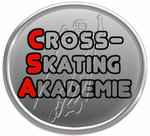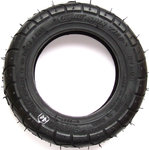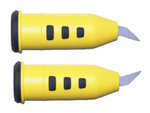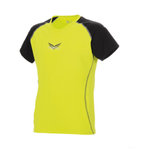Cross-Skate-Shop - SRB, Skitire, Powerlside, SR... How to train and practice - getting started
How to train and practice - getting started
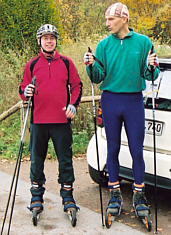
There is an important difference between training and practising. Training improves physical characteristics like strength or stamina. Practising improves motor skills and skating technique. Although you should do both because this sport cannot be pursued without physical condition (=overall physical shape) or completely without technique. In order to improve both you should separate practise sessions and training sessions.
Practising always demands your full attention. You should take your time, fully focus on what you are doing and not practise for too long or get too exhausted. The motto here is: as often as possible but only as long as necessary, which could just be several minutes at a time. Practising for too long can sometimes be counterproductive in any case.
For a beginner's course, of course, practise is always the main focus, even if it is exhausting. Now for the training:
40s (35 to 45 minutes)
a) Constantly high pace.
Don't start skating at a high pace right from the start but approach your endurance limit after 10 minutes of reasonably fast warm-up. This pace is exhausting but you should be able to continue with this tempo (this endurance) for 20 to 30 minutes. If you don't feel like pushing yourself too hard, you could also opt for medium endurance - sometimes you might not have the time for a longer training session but neither do you feel like pushing yourself to the limit. 5 minutes before the end of the session you just go back to "normal medium pace".
b) Increase of pace
As in a), 10, maybe 15 minutes of easy warm-up skating. Then 15 to 20 minutes of very carefully but continually increasing the pace so that the last one or two minutes are so fast that you wouldn't be able to keep it up any longer (maximum for a few minutes). The last 5 minutes just skate at a relaxed pace.
c) Short intervals.
Warm-up as in b), then 6 x 2 minutes of increased pace with 1 minute of rest by slow skating in between. You are free to choose your own tempo in those fast intervals but you probably won't be dawdling and even if you are a bit too fast to start with - you will almost automatically regulate the tempo. The last 5 minutes just skate at a relaxed pace.
60s (55 to 70 minutes):
a) Endurance training only.
Very simple. After around 10 minutes of very calm warm-up skating, go on to low or medium pace and continue to skate for around an hour. Avoid endurance peaks, ie restrained skating on uphill stretches.
b) Strength endurance training.
Have a long warm-up skate. Then select power-consuming periods of between 1 and 8 minutes in which particular strain is put on specific muscle groups. You can, for instance, purely work your legs (skating step) or just the double pole push-off. Even better, do it when the resistances are higher, like on off-road terrain, in headwind on on a slight uphill slope. Another interesting version is to alternate between 1 minute of double pole push-off and 1 minute of skating step for altogether about 12 to 20 minutes. You could also work the whole of your musculature (as long as it isn't too intensive), ie skating up quite a steep slope for 3 x 5 minutes, holding back a little bit in order to move in a very calm and slow manner (strength endurance!). The power intensive endurance sections should last between 15 and 30 minutes. The rest is warm-up skating and "rolling out", as well as "recovery skating" in between.
c) Interval training.
15 minutes of warm-up skating, then (on a familiar route) go fast for 4 x 1000, 1500, or 2000 m. Active rest periods of 2:00, 2:30 or 3:00 minutes by rolling on calmly. At the end, of course, "roll out" again.
90s (80 to 100 minutes):
a) Endurance training only.
An absolutely relaxing treat. After 15 or even 30 minutes of very calm warm-up, increase the tempo only minimally and continue this slow tempo right until the end of the training. Avoid endurance peaks, ie restrain yourself on uphill stretches. Always have a drink with you.
b) Mixing different tempos. This is popular and varied. As always, start with a very calm warm-up and then "mix" different speeds: a 30 second burst of speed up until the next tree, change tempo at every junction, tempo increases, uphill sprints, tempo increase in tailwind, etc. Inbetween, always have calm stretches for recovery.
c) Endurance training with faster end stretch. Do an endurance unit for three quarters of the way and then increase your speed during the last quarter (around 20 minutes) - try to go around 15 to 30% faster (as the mood takes you.) Be careful not to go too fast. This is not supposed to be a life-or-death sprint.
It is quite remarkable that the efficiency of training clearly decreases after 100 minutes of endurance. Some 90 minute training can do more for your endurance than a 120 minute one!
These were the ingredients and now for the recepies....
Your training time may, of course, be limited. It also depends in which training phase you are.
We recommend an endurance training over a course of several weeks for those who just want to switch off during training or those who want to build up their form at the beginning of season.
Following that, there should be 5 to 8 weeks of endurance training units of type a).
Thereafter, it would be ideal if a week of training included a variation of lenghts of units. Even if you only manage to train twice a week there should always be an endurance training unit. It also should include a more intensive unit or at least a unit of medium intensity.
Commited Cross-Skaters who train at lest 4 or 5 times per week might even include 2 more intensive units in their weekly training (intervals, power endurance, constantly high pace). These intensive units should not, however, be the same. The rest should be endurance units or medium intensive units like endurance training with faster end stretch or mixing different tempos.
How often do I train?
It is best to train less at first and then slowly increase your training units in number per week as well as intensity of training. Give yourself a break by either alternating tough training weeks with less intensive weeks or perhaps increasing training intensity over a period of 2 to 4 weeks and then having a more "relaxing" week. It would be almost ideal to train every alternate day because there already is a small decrease in form after 2 days off training. Those who train quite a lot have to be careful not to do intensive training on consecutive days. So on the day before an interval training, it is important to take a day off or to only to do a relaxed training unit.
Just listen to your body and how training is received. Some will be surprised how varied and effective training can be - with the manageable numbers of training units above. "Specialists" like extreme long-distance cross-skaters or biathletes might require (a few) additional training units, but even they can achieve 90% of their form in this way. Other hobby-cross-skaters don't need to force themselves to do very long distances and, instead, use these few ingredients to design their own training satisfactorily. So to go on longer trips can just for fun!
Good Luck!
Frank Röder


